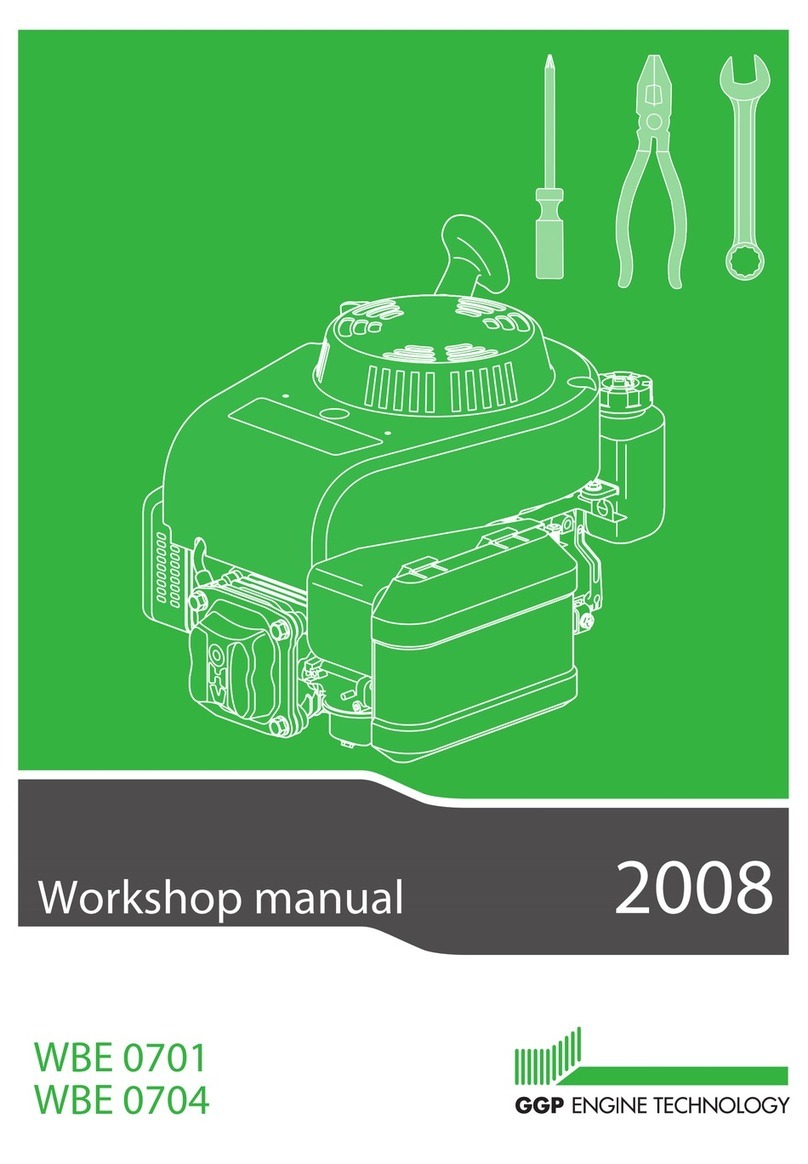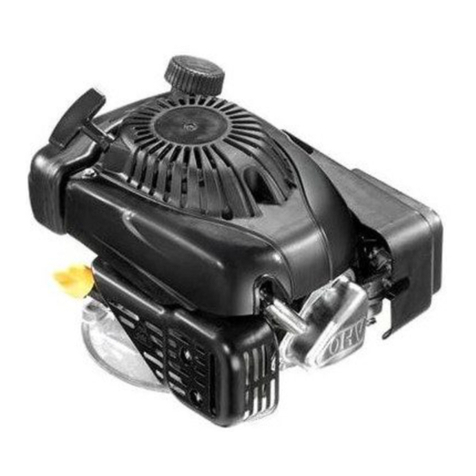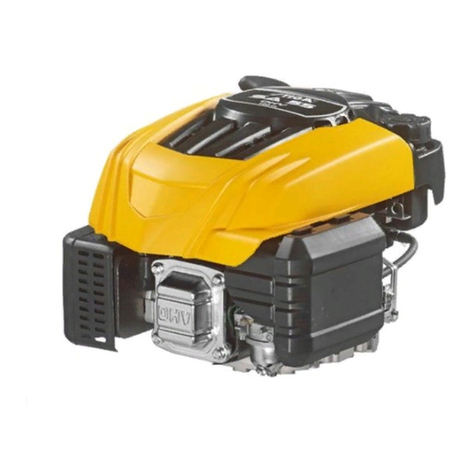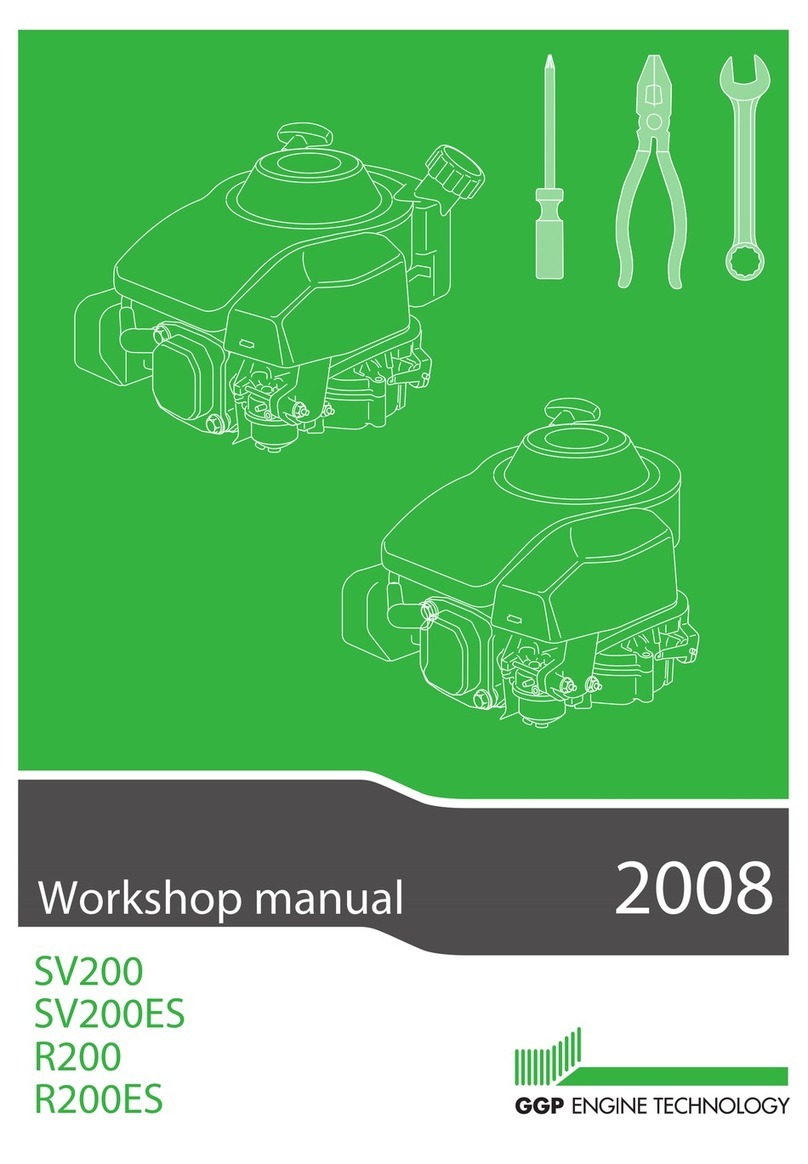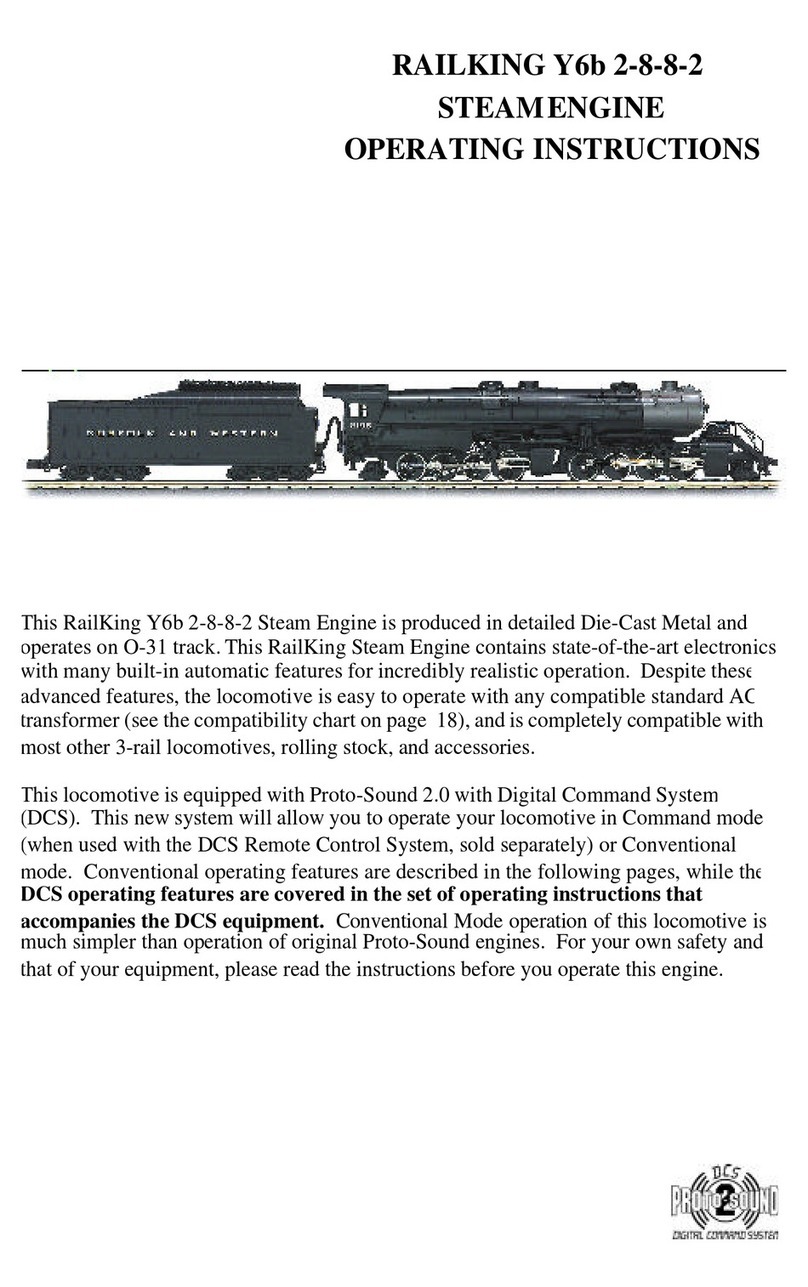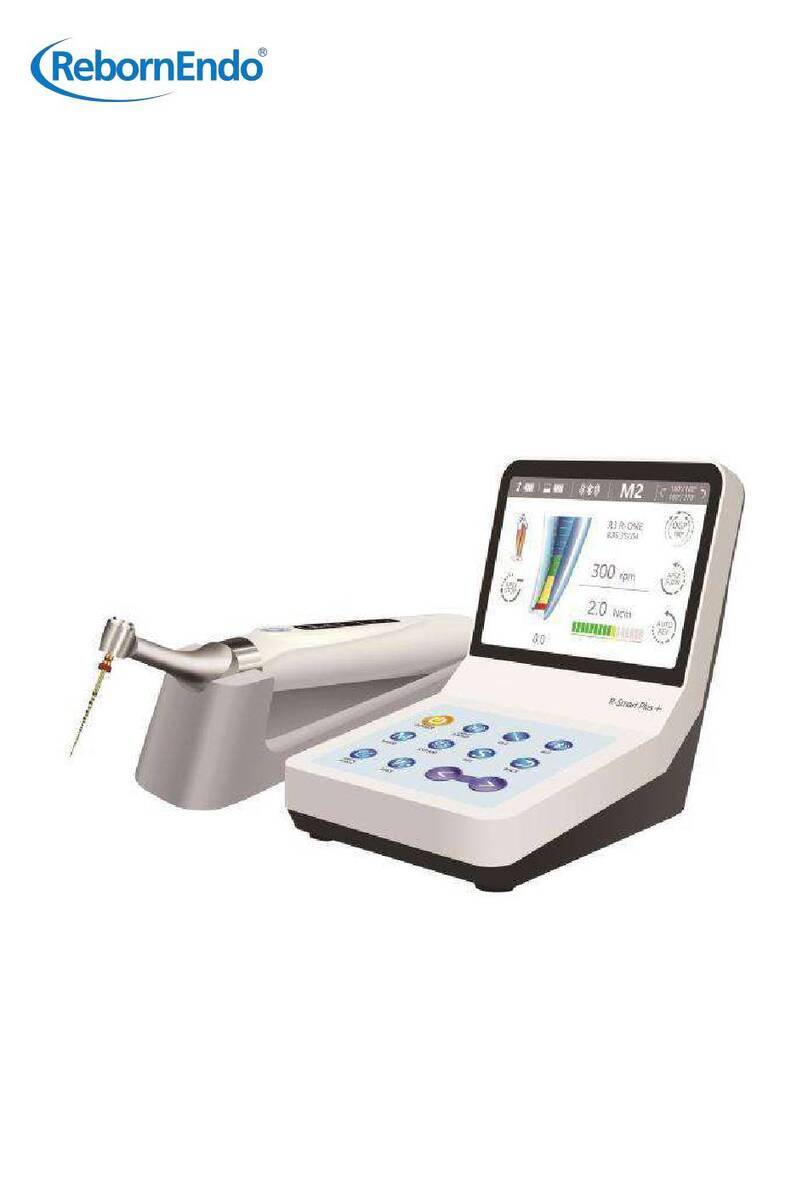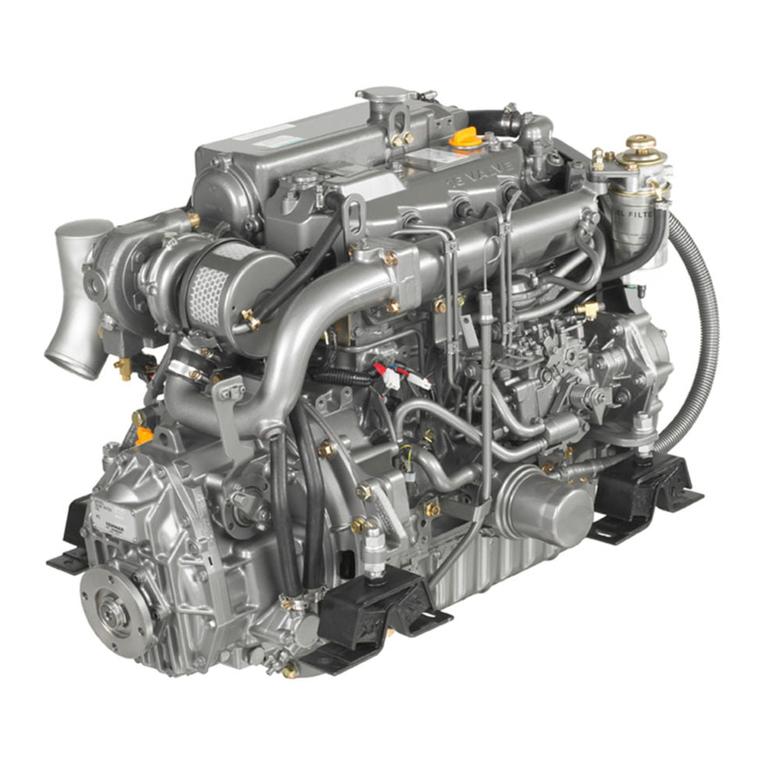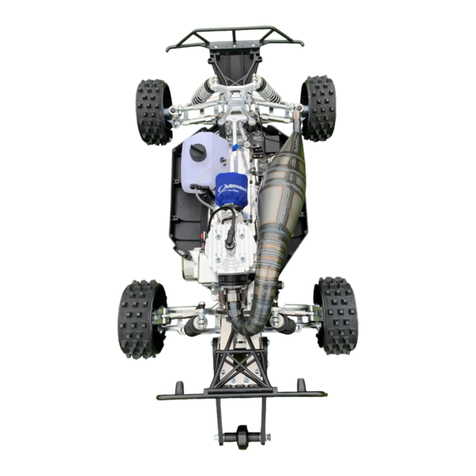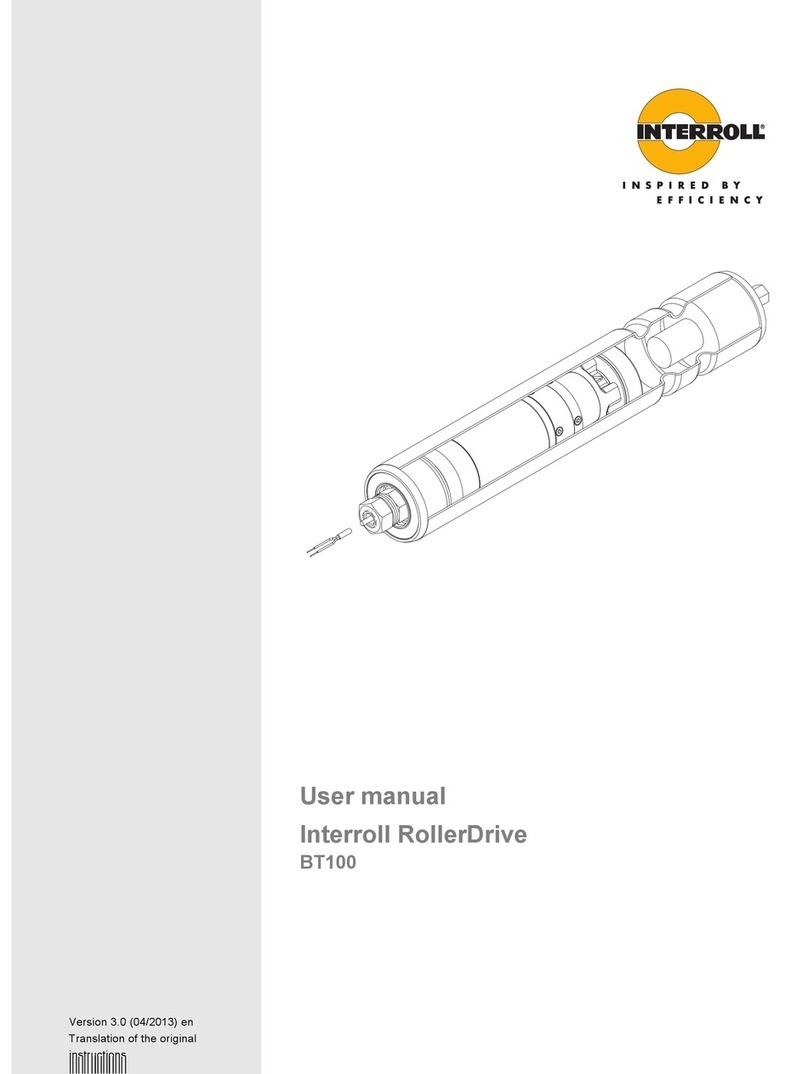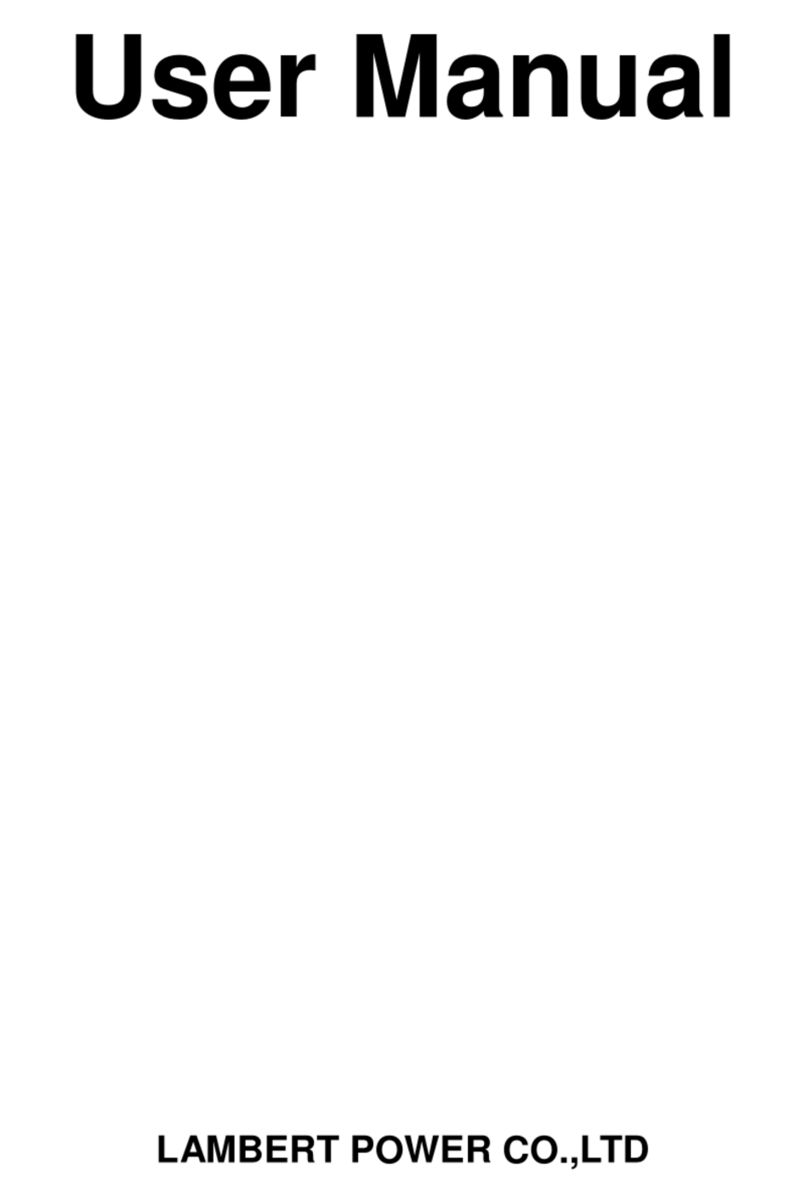GGP Mountfield SV-150 Instruction manual

MANUALE D'OFFICINA
WORKSHOP MANUAL
MANUAL D'ATELIER
KUNDENDIENSTHANDBUCH
MANUAL DE TALLER
The manufacturer reserves the right to make all the necessary technical or commercial
improvements to its products, so there may be some differences between the series of
lawnmowers and the contents of this manual. However the basic specifications and
different operating procedures will remain the same.
SV 150
REL. 1.0 - 01/2005
2005
PRINT
INDEX

MAIN CHAPTERS
1. Rules and procedures for Service Centres
This chapter covers all the main aspects of the
relationship between the manufacturer and the
service centres.
A close collaboration between the manufacturer
and the service centres is conclusive for solving
problems in the most effective way as well as
maintaining an image of efficiency and reliability.
Compliance with these brief and simple guide-
lines will facilitate this task and prevent general
misunderstandings and time-wasting for both
the manufacturer and the service centre.
2. General and safety regulations
This chapter covers the main aspects of a serv-
icing procedure and the general rules for guaran-
teeing a successful service which protects the
environment and respects the safety of both the
serviceman and the user of the apparatus.
3. Technical data and specifications
This chapter summarizes all the technical infor-
mation regarding the engine, tuning data, tight-
ening torques, expendable materials and spare
parts available.
4. Engine tuning
This chapter describes how to plan a mainte-
nance program and outlines a servicing proce-
dure for general engine tuning.
5. Troubleshooting
This chapter summarizes all the main operating
faults and indicates probable causes and proce-
dures for solving them.
6. Servicing procedures
This chapter describes the servicing procedures
for dealing with the most frequent operating
faults.
The descriptions follow a logical sequence and
may cover operations not strictly linked to the
one described.
In this case, you should read the entire proce-
dure carefully so that you can leave out any irrel-
evant operations without missing necessary
steps.
01/2005
SV 150
i.0
TABLE OF CONTENTS
1 / 1
WORKSHOP MANUAL
page
from 2004 to ••••
CONTENTS
ii 0 Introduction
1.1 0 Rules and procedures for Service Centres
2.1 0 General and safety regulations
3.1 0 Technical data and specifications
4.1 0 Testing and tuning the engine
5.1 0 Troubleshooting
6.1 0 Tank and supply
6.2 0 Starting system
6.3 0 Intake system
6.4 0 Carburation
6.5 0 Carburettor governor system
6.6 0 Ignition system
6.7 0 Turning off and stopping the engine
6.8 0 Exhaust system
6.9 0 Engine block
PRINT

INTRODUCTION
The purpose of this manual is to help Service
Centres service, disassemble and repair SV150
engines.
Each page of this manual states the following infor-
mation:
A) Engine type or types the page is referring to.
B) Page number, specifically:
– the first two figures separated by a point indi-
cate the section and the chapter
– the third figure indicates the modification
index.
C) Temporary validity of the page, with reference to
the year of manufacture [3.1.A]or serial
numbers.
D) Date of release.
E) Page number and total number of pages dedi-
cated to the subject.
F) Any previous or ensuing pages dedicated to the
subject.
G) Any chapters before or after the current one.
The manual refers to the following symbols:
Warns of operations that should be carried
out with utmost care to avoid impairing the func-
tionality and safety of the lawnmower.
Warns of operations that should be carried
out with utmost care to avoid injury to the oper-
ator.
Reference to another procedure or part of
the manual.
NOTE
All references to “right”, “left”, “front”, “rear”,
“upper” and “lower” refer to the engine installed on
the lawnmower and viewed from the user’s operat-
ing position.
The manual has left out the simplest and quickest
operations that can be handled by a good mechan-
ic, while concentrating more on specific aspects
and the best servicing procedures.
Please read all the contents of this manual to
become familiar with the basics of the engine,
which is fundamental for operating in a logical man-
ner without making errors or wasting time.
All problems related to use are fully covered in the
user manual.
01/2005
SV 150
ii.0
INTRODUCTION
1 / 1
WORKSHOP MANUAL
page
from 2004 to ••••
6.3 INTAKE SYSTEM
GENERAL INFORMATION
The intake system uses an air filter which is directly
connected to the carburettor and a manifold which
conveys the air/petrol mixture towards the induction
valve.
The intake system can malfunction in the following
ways:
• no or difficult starting or insufficient power (if not
due to other causes):
= Air filter clogged [6.3.A];
The air filter is found on the right hand side of the
engine and can be inspected without having to
remove other parts.
The entire body of the filter only needs to be
removed in case of access to the carburettor.
SERVICING PROCEDURES
A) Maintenance of filtering element
1 Clean the area around the filter cover (1).
2 Remove the cover (1) by releasing the rear flap
(2) and remove the sponge filtering element (3).
IMPORTANT! The filtering element must be
kept clean and soaked in oil. Replace it if bro-
ken, cracked or fragmented. Do not use com-
pressed air for cleaning the filtering element.
3 Wash the sponge filtering element in water and
detergent and dry it with a clean cloth.
4 Soak the filtering element with 2 spoonfuls of
clean engine oil and squeeze it several times to
spread the oil evenly (4).
5 Remove any excess oil with a clean cloth.
6 With a jet of compressed air, clean inside the
body (5) of the filter by removing dust and
remains of grass, making sure that the intake
pipe hole (6) is closed so that nothing gets
inside the pipe.
7 Install the filtering element (3) in place and close
the cover (1).
SV 150
6.3.0
INTAKE SYSTEM
1 / 2
WORKSHOP MANUAL
page
from 2004 to ••••
01/2005
4
6
2
5
3
3
1
1
A C
F
E
F
D
GBG
PRINT

1.1 RULES AND PROCEDURES FOR SERVICE
CENTRES
A) Warranty validity
The warranty is supplied under the terms, pro-
cedures and limits stated in the contract.
B) Post-warranty assistance
The Service Centre is obliged to compile a
report for every service, stating the engine seri-
al number[3.1.A], the summary of claims, the
operation carried out and any spare parts used.
A copy of these reports must be kept and made
available to the manufacturer together with the
replaced parts, in case clients should make fur-
ther complaints.
C) Fault notification
The manufacturer should be informed of all
faults that recur frequently; this allows it to care-
fully examine the problem and make corrections
on the production line.
Similarly, the manufacturer shall report any
faults traced on its engines, indicating the best
troubleshooting procedure.
D) Requesting spare parts
When asking for spare parts, you must quote
their code by referring to the exploded views
corresponding to the year of manufacture
reported on the nameplate [3.1.A].
01/2005
SV 150
1.1.0
RULES AND PROCEDURES FOR SERVICE CENTRES
1 / 1
WORKSHOP MANUAL
page
from 2004 to ••••
PRINT

2.1 GENERAL AND SAFETY REGULATIONS
A) Qualification of operators
All maintenance, disassembly and repairs must be
carried out by expert mechanics who are familiar
with all the accident prevention and safety regula-
tions after reading through the procedures in this
manual.
B) Safety measures
All the engines are built in conformity with the
European safety regulations in force.
To maintain initial safety levels in the long term, the
Service Centre should take proactive measures by
making checks whenever possible.
Every time you are asked to service the engine (or
the lawnmower on which it is installed), you should:
1) check:
– that the safety devices function correctly;
– that the guards and covers have not been
removed;
– that the nameplates or specification labels
have not been removed or made illegible,
as they form an integral part of the safety
devices.
2) also:
– make sure the safety devices function cor-
rectly if they have been tampered with or
removed;
– replace ineffective, damaged or missing
guards and covers;
– replace illegible labels;
– do not carry out operations or modifica-
tions on the lawnmower or on the engine
that could affect their performance or lead
to an improper or different use from the
one for which it has been designed and
approved;
– warn the customer that the failure to com-
ply with the above points automatically
voids the warranty and the responsibility of
the manufacturer.
C) Precautions during servicing
The operations described in this manual do not
entail particularly hazardous situations besides the
normal hazard related to mechanical operations
and that can be avoided by taking the necessary
care and attention normally required for this type of
work.
As well as following the usual accident prevention
regulations that apply to most repair shops, we rec-
ommend you:
– disconnect the spark plug cap before servic-
ing;
– protect hands with suitable working gloves,
especially when working near the cutting unit;
– check that you do not cause accidental petrol
leaks or other losses;
– do not smoke when working on the tank or
when handling petrol;
– do not inhale oil or petrol fumes;
– clean up all traces of spilt petrol immediately;
– test the engine in a well-ventilated environ-
ment or where there are adequate exhaust
fume extraction systems;
– do not pollute the environment with oil, petrol
or other waste and dispose of all waste in
accordance with the laws in force.
D) Necessary equipment
All the operations can be carried out with the tools
normally used in a good garage.
Some operations require special equipment and
tools [3.1.F].
E) Symbols and terms used for safety purposes
Some paragraphs in this manual are preceded by
symbols which indicate the following:
Operations that should be carried out with
utmost care to avoid impairing the functionality
and safety of the engine and/or lawnmower on
which it is installed.
Operations that should be carried out with
utmost care to avoid injury to operators.
“WARNING” stresses the risk of injury to oneself
and others if instructions and regulations are not
observed.
01/2005
SV 150
2.1.0
GENERAL AND SAFETY REGULATIONS
1 / 1
WORKSHOP MANUAL
page
from 2004 to ••••
PRINT

A) Identification
All the engines have a
serial number stamped
on the right-hand side of
the crankcase; this 9-
figure code identifies:
The serial number must be reported on every
operating sheet in the warranty application and
is fundamental for identifying and ordering spare
parts.
B) Technical data
Piston displacement .................................... 149 cc
Bore ............................................................. 65 mm
Stroke .......................................................... 45 mm
Minimum speed (SLOW) ................ 2200-2500 rpm
Maximum speed (FAST) ................ 2800-3000 rpm
Fuel tank capacity ..................................... 0.8 litres
Oil sump capacity ..................................... 0.6 litres
C) Adjustments
Distance between spark plug
electrodes ............................................. 0.6-0.8 mm
Coil air gap ....................................... 0.25-0.40 mm
D) Summary of tightening torques
The first number refers to the procedure, while the
number in brackets is an internal reference to the
procedure.
6.1 Conveyor nuts (2) ................................ 4-7 Nm
6.2 Starter screw (6) .................................. 4-6 Nm
6.3 Governor bracket screw (7) ................. 6-8 Nm
6.3 Carburettor screws (8) ......................... 6-8 Nm
6.5 Cylinder head screws (34) ............... 20-25 Nm
6.6 Spark plug tightening torque (1) ...... 16-18 Nm
6.8 Muffler nuts (3) ..................................... 6-8 Nm
6.9 Cylinder head screws (4) (6) ............ 20-25 Nm
6.9 Oil drain plug (12) ............................ 18-22 Nm
6.9 Engine screws (23) .......................... 20-28 Nm
E) Expendable materials
Petrol ........................................... lead-free (green)
minimum lead-
free (green) min-
imum 90N.O.
Engine oil - from 5 to 35 ° C ....... SAE 30
from -15 to +5 °C ..... 5W30 - 10W30
from -25 to + 35°C ... synthetic 5W30
- 10W30
Spark plug ................................... GL4RC Torch or
equivalent
Starter cable ................................ Ø 4.5x2400 mm
F) Special equipment
The number refers to the procedure which
describes the servicing operation.
Speed indicator ......................................... 6.4 - 6.5
Tester for spark test ........................................... 6.6
Universal tester................................................... 6.7
01/2005
SV 150
3.1.0
TECHNICAL DATA AND SPECIFICATIONS
1 / 2
WORKSHOP MANUAL
page
from 2004 to ••••
•- ••• - •••••
Year of manufacture
Date
Daily progressive number
PRINT

G) Spare parts
Below is a list of spare parts available, not including
parts that are easily available or whose replacement
would entail particularly expensive assembly and
disassembly operations.
To order a spare part, refer to the code on the
exploded view regarding the year of manufacture.
1 Complete Sumec SV 150 engine
2 Starter/tank conveyor assembly
3 Tank cap
4 Starter handle
5 Deflector
6 Starter spring
7 Starter assembly
8 Starter hook kit
9 Fuel pipe
10 Conveyor stud bolt kit
11 Nut
12 Oil level pipe assembly
13 Air filter base
14 Screw
15 Filtering element
16 Air filter cover
17 Breather pipe
18 Governor bracket
19 Governor spring
20 Spring
21 Carburettor
22 Governor tie rod
23 Carburettor tie rod
24 Carburettor gasket kit
25 Governor fin disc kit
26 Brake
27 Cable clamp
28 Screw
29 Ignition coil
30 Spark plug cap
31 Spark plug
32 Cylinder head gasket
33 Stud bolt
34 Muffler gasket
35 Muffler spacer
36 Muffler
37 Nut
38 Muffler cover
01/2005
SV 150
3.1.0
TECHNICAL DATA AND SPECIFICATIONS
2 / 2
WORKSHOP MANUAL
page
from 2004 to ••••
34 35 36 38
33 37
12
43
11
9
10
26
2523
24212224
14 15 13
17
2728
20
30
19
31
6
7
8
2
16
18
29
32
5
10
24
1
PRINT

4.1 ENGINE TUNING AND TESTING
A) Operating guidelines
The instruction manual describes a series of opera-
tions for the client to ensure minimum basic main-
tenance. For operations beyond the client’s capa-
bility, the Service Centre should see to keeping the
engine in perfect working order by:
–Tuning the engine whenever possible.
–Recommending the client a routine maintenance
program at set intervals (e.g. at the end of the
season or before a long period of inactivity).
B) Engine tuning program
Whenever the Service Centre is asked to service a
lawnmower or tune an engine, it should follow a
series of operations to ensure the engine is kept
fully serviceable.
Tuning should involve:
– external blowing and cleaning the cylinder head,
cylinder and muffler by removing any remains of
grass and mud;
– checking the oil level, topping up or replacing
parts if necessary;
– inspecting the condition of the starter cable and
checking that it functions correctly;
– cleaning and oiling the air filter [6.3];
– emptying and cleaning the fuel tank and check-
ing the breather pipe [6.1];
– adjusting minimum and maximum speeds [6.4
and 6.5];
– inspecting the condition of the spark plug and
ignition cable; checking the distance between the
electrodes [6.6];
– tightening the screws [6.9];
– functional test [point “C”].
Should the checks and adjustments fail to achieve
a satisfactory result, refer to chapter 5 for trou-
bleshooting.
C) Functional test
A functional test needs to be carried out at the end
of each servicing operation, to check that the oper-
ations made are effective. The test must be per-
formed in compliance with the safety regulations
regarding the use of the lawnmower on which the
engine is installed.
The functional test is carried out as follows.
1. Refuelling and checking the supply system.
When you have refuelled the tank with new petrol,
check the seal of the tank, the cap and the carbu-
rettor pipe.
2. Cold start test. With the throttle control in
“CHOKE”, start the engine a few times to check it
runs normally.
3. Check the engine rpm. When the engine is hot
enough, check the engine speed with the throttle
control set to “SLOW” and “FAST”; the readings
should be equal to the specifications [3.1.B].
4. Hot start test. With the engine hot and the throt-
tle control set to “SLOW”, start the engine a few
times to check it runs normally.
5. Engine brake and stopping test. If you release
the lawnmower brake lever, the engine should turn
off instantaneously and decisively, and the rotation
should stop within 3 seconds.
If all of these operations have a positive result, the
engine can be considered fully serviceable and be
returned to the client.
01/2005
SV 150
4.1.0
ENGINE TUNING AND TESTING
1 / 1
WORKSHOP MANUAL
page
from 2004 to ••••
PRINT

Lawnmower problems
The engine brake cable is
faulty or unfastened
Electrical problems
The microswitch is faulty
Electric current does not reach
the spark plug
Engine block problems
Fouling in the combustion
chamber
Insufficient pressure
Lawnmower problems
The lawnmower blade is loose
Intake problems
Air filter is clogged up
The cable control does not activate the coil earth
switch.
If the microswitch remains locked in the pressed
position, it does not stop the coil earth connec-
tion.
The spark plug is badly connected, faulty or the
electrodes are too far away.
The coil is faulty and does not supply current or
the air gap is too large.
Fouling in the combustion chamber absorbs the
fresh mixture, which makes starting difficult and
may impair valve closure.
The cylinder head screws can loosen causing
the gasket to burn.
The piston rings can wear out due to the pas-
sage of dust caused by an excessively dirty or
unoiled air filter or overheating due to the lack of
oil.
The loose blade stops the effect of the flywheel
and the kick-back can make starting difficult.
The clogged filter can thicken the mixture flood-
ing the engine.
Adjust and/or replace
the cable [6.7.A]
Replace the
microswitch [6.7.B]
Check the spark plug
and the efficiency of
the ignition system
with the spark test [
6.6.A]
Dismount the cylinder
head and remove foul-
ing [6.9.A]
Dismount the cylinder
head and replace the
gasket [6.9.A]
Change the engine
[6.9.C]
Check that the lawn-
mower blade and hub
are securely fastened
Check and clean the
air filter [6.3.A]
01/2005
SV 150
5.1.0
TROUBLESHOOTING
1 / 5
WORKSHOP MANUAL
page
from 2004 to ••••
A) The engine does not start
Probable cause Comment Solution
B) The engine starts badly or kicks back
Probable cause Comment Solution
PRINT

Carburation problems
Carburettor is dirty
Poor seal of carburettor needle
valve
Choke blocked
Lawnmower problems
The lawnmower traction cable
(if present) is bent, jammed or
poorly adjusted
Problems caused by the
engine
Oil in the cylinder head
Supply problems
The tank cap has a clogged
breather pipe
If the jet and the pipes inside the carburettor clog
up, the petrol flow drops and the engine fails to
function correctly.
If the needle valve does not close, excess fuel in
the float chamber can reach the combustion
chamber through the intake manifold. This can
flood the engine and be hazardous as the petrol
can seep through the rings and reach the oil
sump. When mixed with petrol, oil loses its lubri-
cating properties and the engine deteriorates
rapidly.
The choke can get blocked in the closed posi-
tion if the mixture is too oily.
The engine must start with the lawnmower drive
completely disengaged; a poorly adjusted cable
can generate faulty resistance which makes
starting more difficult.
If the engine is tilted with the spark plug at the
bottom, oil may seep into the cylinder head
through the rings. This causes excess pressure
and a reduction of mixture in the combustion
chamber.
The clogged breather pipe in the tank stops the
regular flow of fuel into the carburettor float
chamber. When the fuel has run out in the float
Check and clean the
carburettor [6.4.A]
Clean the carburettor
housing and needle
valve [6.4.A]or
replace the carburettor
[6.4.B]
Check and clean the
carburettor [6.4.A]
and the choke
Check and/or adjust
the lawnmower trac-
tion cable
Dismount the cylinder
head and clean it [
6.9.A]
Clean and/or replace
the cap [6.1.C]
01/2005
SV 150
5.1.0
TROUBLESHOOTING
2 / 5
WORKSHOP MANUAL
page
from 2004 to ••••
C) Starting is difficult and strains the cable
Probable cause Comment Solution
D) The engine starts but does not run
Probable cause Comment Solution
PRINT

Fuel filter clogged
Ignition problems
Insufficient or no current to the
spark plug
Lawnmower problems
The throttle cable is not well
adjusted
Carburation problems
Carburettor dirty
The governor malfunctions or
there is a problem with the tie
rods
Insufficient pressure
chamber, the engine stops. After a few minutes,
the float chamber fills up and the engine is able
to restart, only to stop soon after.
Inside the tank, the filter has a metal mesh which
can clog up with dirt or with a film of old fuel.
Poor connections of the electrical cables or mal-
functioning parts can cause the lawnmower to
function irregularly.
The throttle’s “FAST” position may not corre-
spond with the carburettor’s “FAST” position,
reducing the flow of mixture and hence the
power.
If the jet and pipes inside the carburettor clog
up, the petrol supply drops and the engine
becomes less efficient.
The pneumatic governor fin disc is broken or
does not move freely and therefore fails to work
the carburettor correctly.
The bent or warped governor rods are bent,
deformed or do not move freely, preventing the
governor from reaching its end-of-stroke.
The piston rings can wear out due to the pas-
sage of dust or overheating caused by the lack
of oil.
The cylinder head screws can loosen causing
the gasket to burn.
Empty and clean the
tank [6.1.B]
Check the spark plug
and the efficiency of
the ignition system
with the spark test [
6.6.A]
Check and/or adjust
the throttle cable [
6.5.A]
Check and clean the
carburettor [6.4.A]
Check the entire gov-
ernor system [6.5]
Replace the engine
[6.9.C]
Dismount the cylinder
head and replace the
gasket [6.9.A]
01/2005
SV 150
5.1.0
TROUBLESHOOTING
3 / 5
WORKSHOP MANUAL
page
from 2004 to ••••
E) The engine is inefficient (insufficient power)
Probable cause Comment Solution
PRINT

Environmental problems
The engine is used at a high
altitude
Carburation problems
Air seeps into the carburettor
The governor malfunctions or
there is a problem with the
rods
Starting problems
The coil air gap has been
poorly adjusted
Carburation problems
Governor blocked
Lawnmower problems
The engine brake cable is bent
or jammed
The rarefaction of air in the mountains causes a
drop in power of approx. 10-12% every 1000
metres of altitude.
If air seeps through the gaskets, it can cause the
lawnmower to function poorly and make it diffi-
cult to maintain the minimum speed (2200-2500
rpm).
The pneumatic governor fin disc is broken or
does not move freely and therefore fails to work
the carburettor correctly.
The governor rods are bent, deformed or do not
move freely, preventing the governor from reach-
ing its end-of-stroke.
The air gap adjustment between the flywheel
and coil must be 0.25-0.40 mm.
Excess dirt or a broken spring can impede the
movements of the governor or impede return.
When the lever is released, the earth
microswitch is not pressed.
Advise your client to
adapt the strain of the
lawnmower to the lim-
ited power available.
Replace the carburet-
tor gaskets [6.4.A]
Check the entire gov-
ernor system [6.5]
Adjust the air gap [
6.6.B]and if the prob-
lem persists, replace
the coil [6.6.C]
Check the governor
[6.5.B]
Check and/or adjust
the cable [6.7.A]
01/2005
SV 150
5.1.0
TROUBLESHOOTING
4 / 5
WORKSHOP MANUAL
page
from 2004 to ••••
F) The engine runs irregularly
Probable cause Comment Solution
G) The engine overreved
Probable cause Comment Solution
H) The engine does not turn off
Probable cause Comment Solution
PRINT

Electrical problems
The earth cable is disconnect-
ed or broken
Lawnmower problems
Blade not balanced
Engine screws loose
Problems with the stopping
system
Faulty or no clutch lining
The broken or disconnected cable prevents the
microswitch from closing the electric circuit to
earth
The imbalanced or loose blade causes judders
and the premature wear of all the parts inside the
engine.
An engine with loose screws can be hazardous
for the user and can break internal parts.
The thickness of the clutch lining normally guar-
antees good braking action for the entire dura-
tion of the engine.
If it comes away from the lever, act immediately
to stop the metal from rubbing against the fly-
wheel causing hazardous sparks.
Check the earth con-
nection [6.7.B]
Dismount and balance
the blade and tighten
the screws to the
specified levels
Tighten the screws to
the specified levels [
6.9.C]
Replace the engine
stopping system [
6.7.D]
01/2005
SV 150
5.1.0
TROUBLESHOOTING
5 / 5
WORKSHOP MANUAL
page
from 2004 to ••••
J) The engine judders
Probable cause Comment Solution
K) The engine does not stop within 3 seconds after it has turned off
Probable cause Comment Solution
PRINT

6.1 TANK AND SUPPLY
GENERAL INFORMATION
The supply system consists of a petrol tank (built
into the upper conveyor) connected to the carburet-
tor by a pipe. A mesh filter on the bottom of the tank
stops deposits and impurities from reaching the
carburettor.
The supply to the carburettor float chamber is
caused by gravity and the volume of petrol taken
from the tank as the engine runs is compensated by
a breather pipe in the cap.
The supply system can malfunction in the following
ways:
• difficult or failed start or insufficient power (if not
due to other causes):
= Petrol filter dirty [6.1.B];
= Petrol pipes clogged;
= Inefficient breather pipe [6.1.C].
SERVICING PROCEDURES
WARNING! All work on the tank and on the sup-
ply system must be carried out in safe condi-
tions, so:
– do not smoke;
– always empty the tank;
– work in a ventilated environment away from
naked flames or unprotected sources of heat;
– collect petrol in a suitable container with a
cap using a funnel and avoid spilling it on the
work bench;
– remove all traces of spilt petrol immediately;
– check you have connected the pipes before
pouring petrol back into the tank
A) Emptying and removing the tank
1 Remove the conveyor (1) secured by three nuts
(2).
2 Remove the ring (3) of the petrol pipe (4) from
the carburettor side and drain all the fuel from
the tank into a suitable container.
3 For assembly, follow the above procedures in
SV 150
6.1.0
TANK AND SUPPLY
1 / 2
WORKSHOP MANUAL
page
from 2004 to ••••
01/2005
3
2
4
2
2
1
6
PRINT

reverse order.
WARNING! Check that the petrol pipe (4) is
intact and secured correctly before pouring in
new fuel.
B) Cleaning the tank
11 Remove the conveyor (1) secured by three nuts
(2).
12 Remove the ring (5) from the tank side, discon-
nect the petrol pipe (4) and drain all the fuel from
the tank into a suitable container.
13 Remove the tank cap (6) and blow compressed
air through the tube (7) to remove deposits from
the internal mesh filter.
14 Keep the tube hole (7) closed, pour in approx.
100 cl of clean petrol and shake well to clean
inside the tank.
15 Empty the tank and dispose of the petrol used
for cleaning in accordance with the laws in
force.
16 Remount the conveyor.
WARNING! Check that the petrol pipe (4) is
intact and secured correctly before pouring in
new fuel.
C) Checking and cleaning the breather pipe
21 Remove the cap (6) and pull out the gasket (8)
and the sponge (9).
22 Check that:
– the gasket (8) is intact and without cracks or
fissures;
– the air passages (10) inside the cap are not
clogged;
– the sponge (9) is not crushed or broken.
NOTE
Always replace the entire cap if the gasket or
sponge is damaged.
Tightening torques
2Conveyor nuts ...................................... 4-7 Nm
SV 150
6.1.0
TANK AND SUPPLY
2 / 2
WORKSHOP MANUAL
page
from 2004 to ••••
01/2005
10
8
6
5
4
6
89
7
PRINT

6.2 STARTING SYSTEM
GENERAL INFORMATION
The starting system is built into the upper conveyor
(which also includes the tank) and consists of a
cable wound onto a pulley.
The movement from the pulley to the flywheel (and
the engine shaft) is transmitted by a pair of hooks.
The cable is returned and rewound by a spiral
spring.
Other than the possibility of the cable breaking, the
starting system may malfunction in the following
ways:
• failed start after attachment (if not due to other
causes):
= cable too short, therefore does not supply
adequate number of revs to the engine [
6.2.A].
• the pulley is not attached to the flywheel. This
can be detected when the cable unwinds with-
out strain :
= the hooks are deformed or broken [6.2.B].
• inefficient or no return of the cable:
= spring broken [6.2.C].
In all cases, remove the conveyor to make the nec-
essary checks or repairs.
SERVICING PROCEDURES
A) Replacing the cable
1 Remove the conveyor with the tank [6.1.A].
2 Remove the internal screen (1) fastened by the
screw (2).
3 Keep hold of the pulley (3) and slowly unwind
(clockwise) the entire cable (4) to gradually
release the return spring. If the cable breaks, the
spring will be already released and you will only
have to unwind the cable.
4 Undo or cut the knot at the end of the cable or
remove the section still attached to the pulley.
5 Cut a section of cable (4) (Ø 4.5 mm and 2.40 m
long), fit one end in the pulley hole (3) and make
a knot to prevent it from slipping out.
SV 150
6.2.0
STARTING SYSTEM
1 / 3
WORKSHOP MANUAL
page
from 2004 to ••••
01/2005
5
3
4
4
4
2
1
3
PRINT

6 Fit the other end of the cable in the conveyor
hole, securing it to the handle (5) with a knot.
7 Turn the pulley (3) and the cable (4) anticlock-
wise for approx. 5 complete revs to load the
spring, then release the pulley carefully to wind
the entire cable onto the pulley.
8 Check that the pulley (3) is free to rotate.
9 After pulling the entire length of the cable, check
that the pulley (3) is able to complete 2-3 turns
before compressing the spring.
10 Remount the internal screen (1).
11 Remount the conveyor [6.1.A].
B) Replacing the hooks
21 Remove the conveyor with the tank [6.1.A].
22 Loosen the central screw (6) and dismount the
bushing (7) and hooks (8) without letting the pul-
ley (3) slip out of place.
NOTE
The screw (6) has a left-handed thread and
therefore should be unscrewed clockwise.
NOTE
Always replace the hooks (8), the bushing (7)
and the screw (6) in one block.
23 Mount the new hooks (8), taking care to position
them correctly with the bushing (7) and the
guides in the pulley hub (3). Tighten the screw
(6) anticlockwise so that the pulley rotates
smoothly.
24 Remount the conveyor [6.1.A].
C) Replacing the pulley
31 Remove the conveyor with the tank [6.1.A].
32 Dismount the internal screen (1) fastened by the
screw (2).
SV 150
6.2.0
STARTING SYSTEM
2 / 3
WORKSHOP MANUAL
page
from 2004 to ••••
01/2005
8
8
3
6
8
3
4
8
7
7
7
6
PRINT

33 If the spring is not already released, keep hold
of the pulley (3) and slowly unwind the entire
cable (4) clockwise to release the return spring
gradually.
34 Dismount the hooks [point “B”].
35 Remove the pulley (3), making sure that the
return spring (9) stays in place underneath the
pulley.
WARNING! Carry out this operation with
utmost care to avoid injury when the spring
suddenly unwinds, as it could slip out of
place.
36 Clean the inside of the conveyor with degreas-
ing liquid by removing any leftover dirt or
grease.
37 Cut a section of cable (4) (Ø 4.5 mm and 2.40 m
long), fit one end in the pulley hole (3) and make
a knot to stop it from slipping out.
38 Fit the other end of the cable in the conveyor
hole and secure it to the handle (5) with a knot.
39 Spray some silicone lubricant onto the spring (9)
and apply liquid grease to inside the conveyor
housing. Check that the spiral spring (10) is
securely lodged in the conveyor housing and
put the pulley (3) back in place so that the inside
end of the spring (9) is firmly lodged in the slot
on the conveyor.
40 Refit the hooks [point “B”].
41 Turn the pulley (3) and the cable (4) anticlock-
wise for 5 complete turns in order to load the
spring, then release the pulley carefully to wind
the entire cable onto the pulley.
42 Check that the pulley (3) rotates freely.
43 After pulling the entire length of the cable, check
that the pulley (3) is able to complete another 2-
3 turns before compressing the spring.
44 Remount the internal screen (1).
45 Remount the conveyor [6.1.A].
Tightening torques
6Starter screw ........................................ 4-6 Nm
SV 150
6.2.0
STARTING SYSTEM
3 / 3
WORKSHOP MANUAL
page
from 2004 to ••••
01/2005
10
9
9
3
PRINT

6.3 INTAKE SYSTEM
GENERAL INFORMATION
The intake system uses an air filter which is directly
connected to the carburettor and a manifold which
conveys the air/petrol mixture towards the induction
valve.
The intake system can malfunction in the following
ways:
• no or difficult starting or insufficient power (if not
due to other causes):
= Air filter clogged [6.3.A];
The air filter is found on the right hand side of the
engine and can be inspected without having to
remove other parts.
The entire body of the filter only needs to be
removed in case of access to the carburettor.
SERVICING PROCEDURES
A) Maintenance of filtering element
1 Clean the area around the filter cover (1).
2 Remove the cover (1) by releasing the rear flap
(2) and remove the sponge filtering element (3).
IMPORTANT! The filtering element must be
kept clean and soaked in oil. Replace it if bro-
ken, cracked or fragmented. Do not use com-
pressed air for cleaning the filtering element.
3 Wash the sponge filtering element in water and
detergent and dry it with a clean cloth.
4 Soak the filtering element with 2 spoonfuls of
clean engine oil and squeeze it several times to
spread the oil evenly (4).
5 Remove any excess oil with a clean cloth.
6 With a jet of compressed air, clean inside the
body (5) of the filter by removing dust and
remains of grass, making sure that the intake
pipe hole (6) is closed so that nothing gets
inside the pipe.
7 Install the filtering element (3) in place and close
the cover (1).
SV 150
6.3.0
INTAKE SYSTEM
1 / 2
WORKSHOP MANUAL
page
from 2004 to ••••
01/2005
4
6
2
5
3
3
1
1
PRINT

B) Removing the filter body
11 Clean the area around the filter cover (1).
12 Remove the cover (1) by releasing the rear flap
(2) and take out the sponge filtering element (3).
13 To remove the filter body (5), loosen the screw
(7) fastening the governor system bracket and
the two screws (8), remembering that both these
screws also fasten the carburettor to the engine
block.
14 Disconnect the oil vapour circulation pipe (9).
Tightening torques
7Governor bracket screw ...................... 6-8 Nm
8Carburettor screw ................................ 6-8 Nm
SV 150
6.3.0
INTAKE SYSTEM
2 / 2
WORKSHOP MANUAL
page
from 2004 to ••••
01/2005
5
2
9
8
8
7
1
3
5
PRINT
Table of contents
Other GGP Engine manuals
Popular Engine manuals by other brands
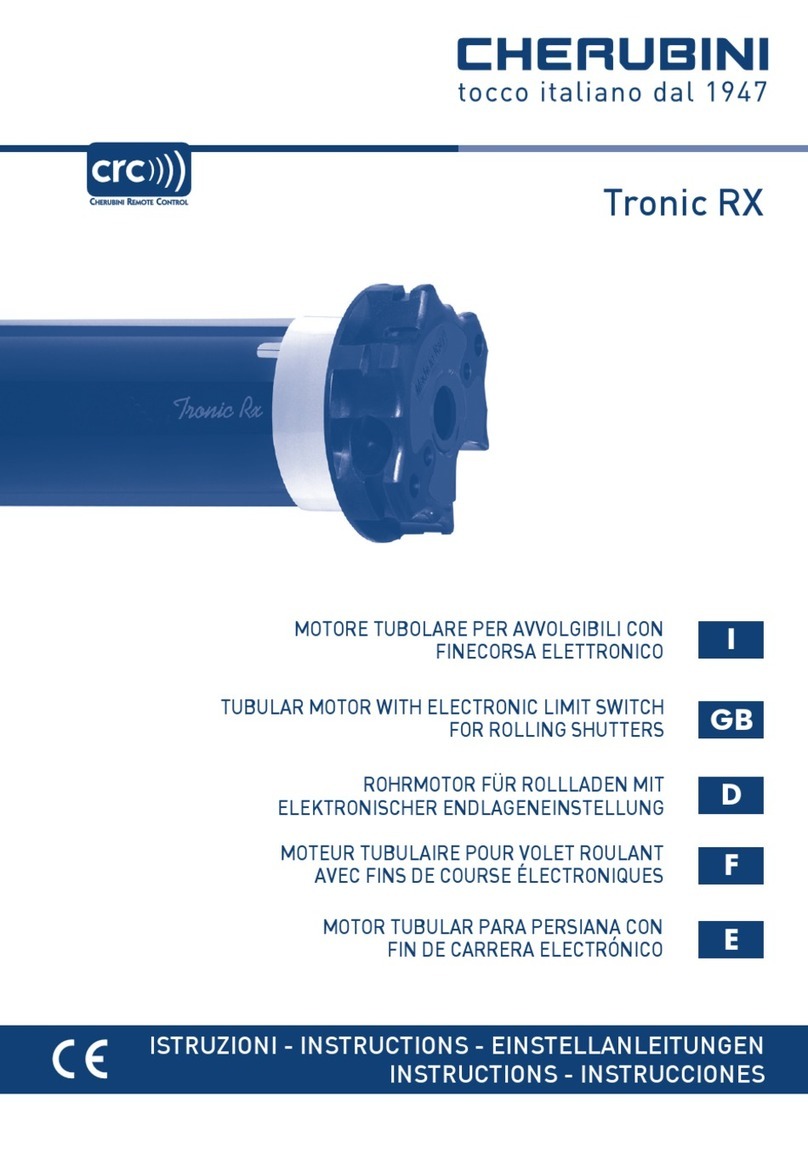
CHERUBINI
CHERUBINI Tronic RX instructions
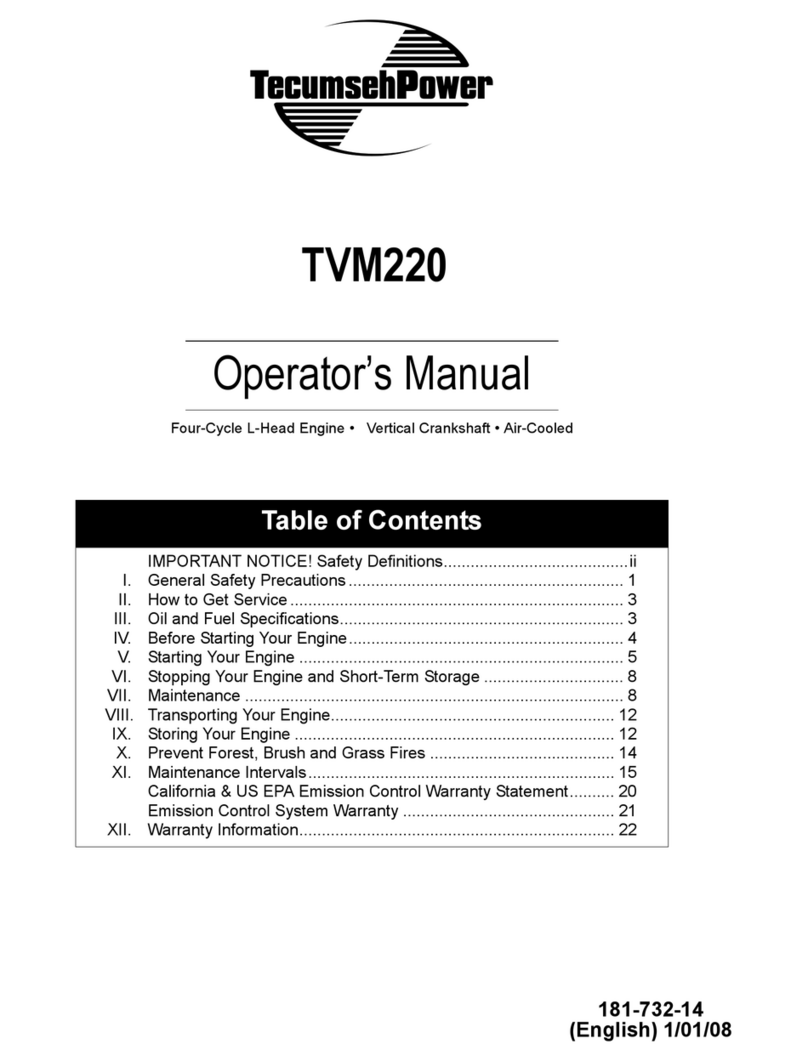
Tecumseh
Tecumseh TVM220 Operator's manual
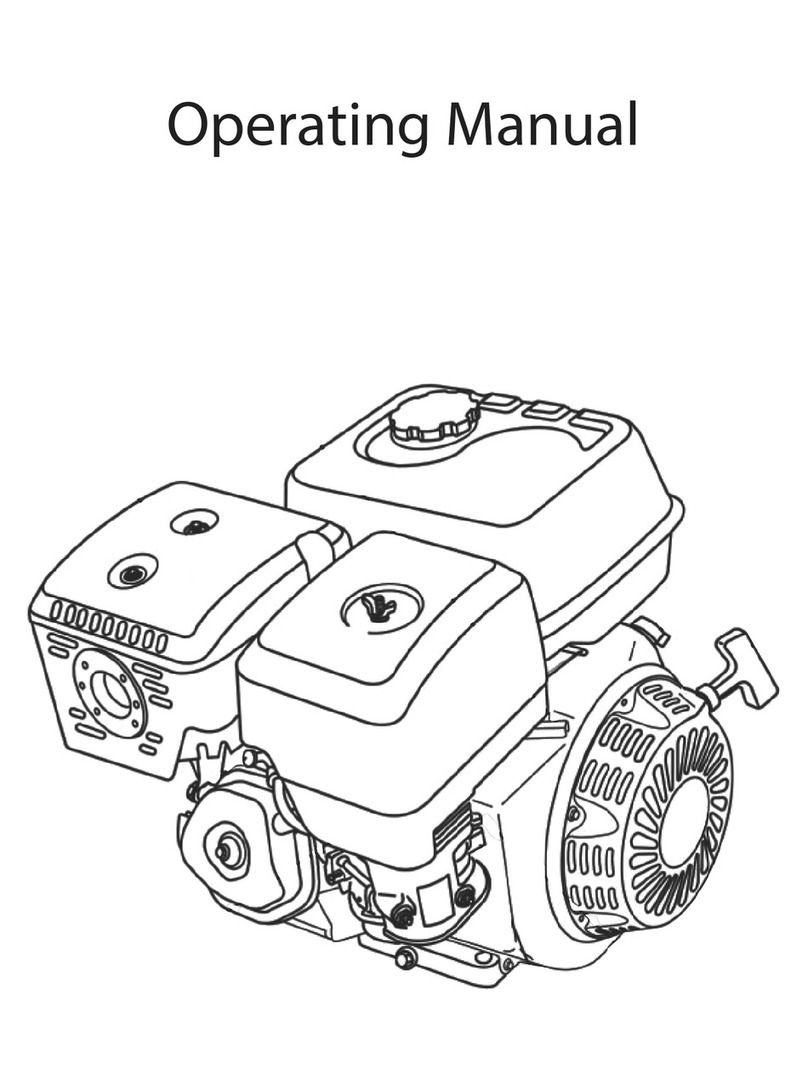
GOSS Power Products
GOSS Power Products AP156F operating instructions
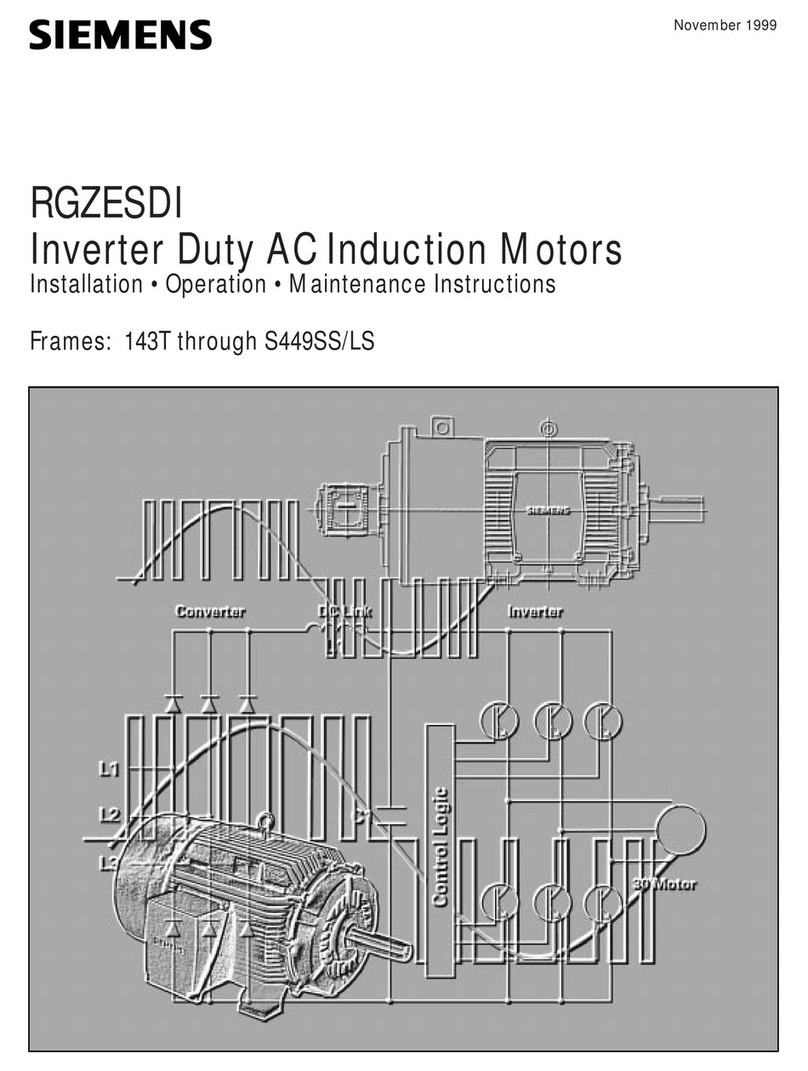
Siemens
Siemens RGZESDI Installation and operation manual
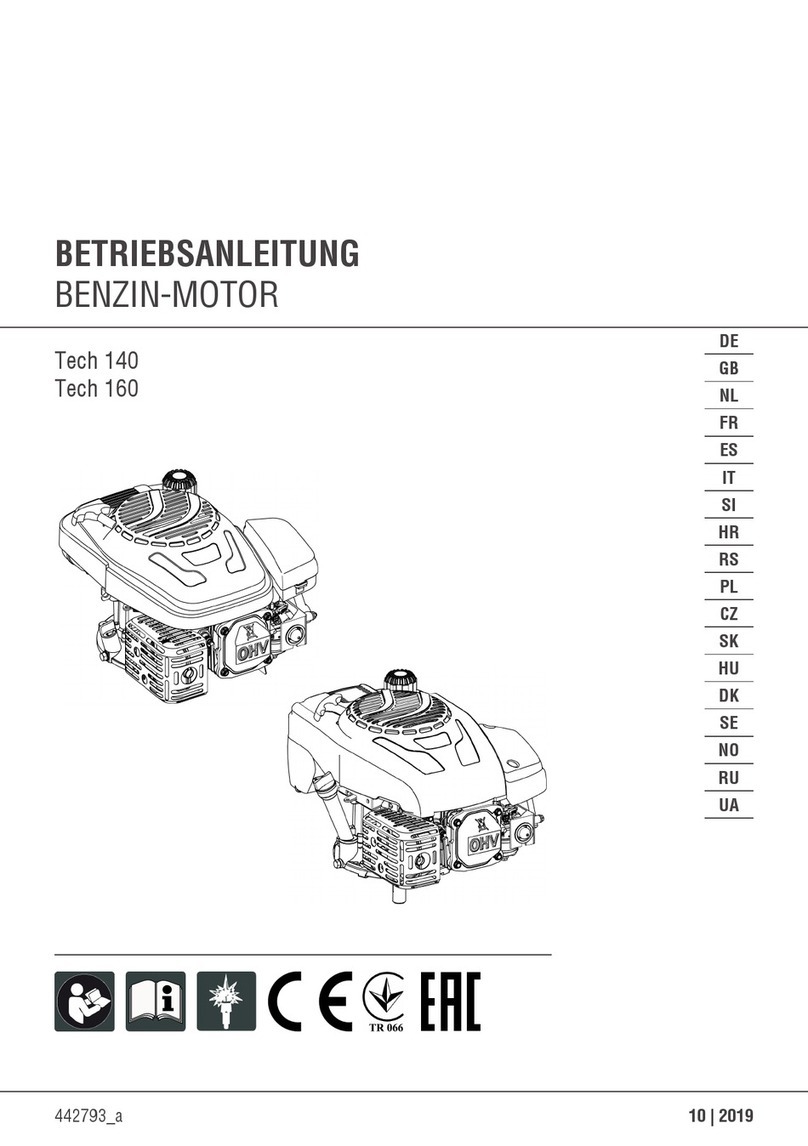
AL-KO
AL-KO Tech 140 OHV Instructions for use
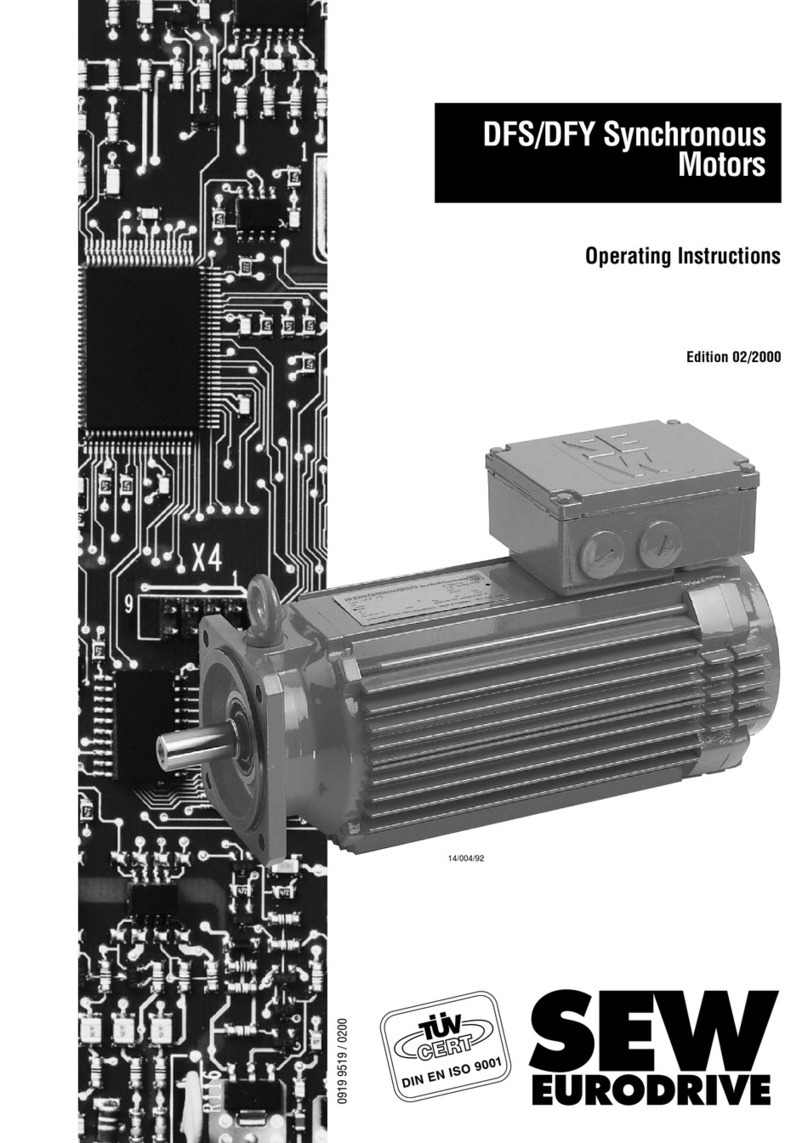
SEW-Eurodrive
SEW-Eurodrive DFS Series operating instructions
